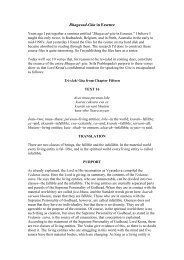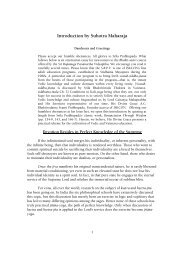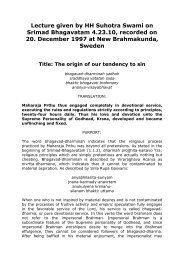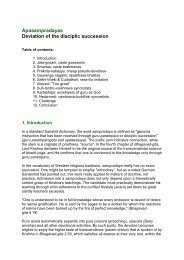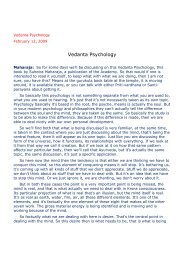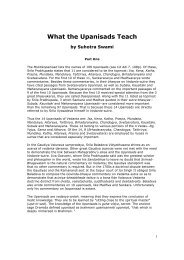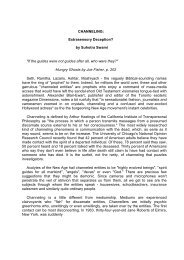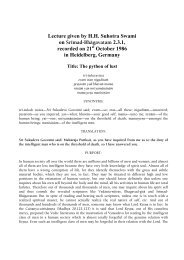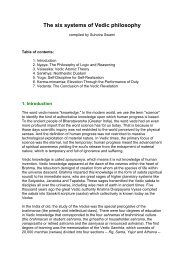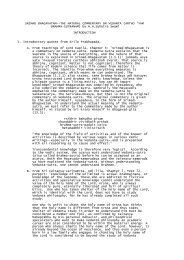Tantra
Tantra
Tantra
Create successful ePaper yourself
Turn your PDF publications into a flip-book with our unique Google optimized e-Paper software.
<strong>Tantra</strong><br />
by R. T. Crowley (December 1980)<br />
From one of our readers we have received the following letter, which is<br />
a reaction to the article "Guruism - A Hindu Counter-mission"<br />
published in Up-date IV 1/2:<br />
Dear Sirs,<br />
Tantrism is a phenomena which is little understood by Western<br />
scholars. because tantrism is largely a "lost science", only a few<br />
rudiments of which are left to inspect. Modern tantrism is only a<br />
degenerate remnant of what was once a vast body of knowledge, of<br />
which only a small portion of books are now known and read (and very<br />
poorly understood). Different tantras are employed in different yugas<br />
and about 64 are applicable at all times. 108 main tantras are said to<br />
have emanated from Shiva. and mostly consist of philosophy and ritual<br />
meant to elevate living beings from the tama-guna. or mode of<br />
ignorance. In the tantras Shiva discusses 5 topics with Durga: 1) the<br />
creation of the world, 2) destruction of the world. 3) worship of devas,<br />
4) mystic powers, 5) five kinds of liberation. There are only a few<br />
tantras which are applicable to vaisnava philosophy (e.g. Brhadvaisnava<br />
tantra, brahma yamala. vishnu yamala, etc.), but none of<br />
these can be said to have anything to do with the sexeo-religious<br />
practices described on page 13 of Up-date.<br />
Modern so-called tantrism as put forward by "gurus" like Rajneesh is<br />
simply good old-fashioned hedonism in the guise of spirituality.<br />
Hedonists like Hugh Hefner made illicit sex socially acceptable, and<br />
now Rajneesh is making it spiritually acceptable. But ochre robe or<br />
not, it all boils down to the same genital-consciousness. Yogis and<br />
swamis who teach this tantrism have not attained true rasa. or divine<br />
pleasure. from their disciplines. This is a ma-lady which plagues the<br />
spiritual development of all members of the imperso-nalist schools of<br />
so-called Hinduism. Because they ignore the spiritualization of the<br />
senses in bhakti-yoga, or service to Hrishikesha (Krsna - the Lord of<br />
the Senses), and strive instead to merge into the brahman effulgence,<br />
their uncontrolled senses get the better of them in the end. They are<br />
impelled by nature to move from tyaga (renunciation) to bhaga<br />
(material enjoyment). To cover up their fall-down from the real path of<br />
advancement. they make a religion out of sex. and claim that their<br />
ordinary biological drives are somehow spiritual. A perfect faith for the
sex-addicted Western world! No wonder Rajneesh has so many<br />
followers.<br />
This modern tantrism is the necessary conclusion of mayavadi<br />
philosophy, made popular in India by Sankaracharya. The assertation<br />
on page 11 of the Up-Date editorial that tantrism has "penetrated into<br />
Hinduism at large under the cover of orthodox religion" is true, insofar<br />
as the mayavada (impersonalist) teachings have almost totally<br />
subverted Hinduism since Sankaracharya's time. It is maintained by<br />
Chaitanya that one of the results of Sankara's teachings is the gradual<br />
destruction of the family system, due to the increase of illicit sex.<br />
Ramkrishna, Aurobindo and others who declared themselves as God<br />
enjoyed the pleasures of maitunya with selected "Divine Mothers". The<br />
issue here is enjoyment, not procreation - the Divine Mother is not a<br />
vehicle for conception, but an object of enjoyment. Mayavadi<br />
philosophy, by denying a higher God than the self, denies the<br />
possibility of pleasure other than material pleasure. This pleasure<br />
becomes the goal of the Godless spiritualist, and to find it, he must<br />
take shelter of sexual enjoyment. But God's plan for sex includes<br />
reproduction of Godly children, as determined by the Vedic samskaras.<br />
Krsna conscious householders, therefore, are enjoined to preserve<br />
their sexual energies only for specific times of procreation in<br />
accordance with sastric injuction. This sort of sex can be seen as<br />
service to Krsna - dharma-virrudho bhutesu kamo'smi, "I am sex<br />
which is not contrary to religious principles" (Bhagavad-gita VII-11).<br />
So, in Krsna consciousness, sex life is allowed when it does not deviate<br />
from the Vedic conclusion, meaning that both partners must be<br />
married in the eyes of God and understand that they are but servants<br />
of God, and that sex is a facility given by God for natural procreation,<br />
and therefore should be engaged in as a service to Him. The tantrists<br />
owe no allegiance to God or God's laws of procreation - their mission is<br />
to deny God and supplant the natural spiritual pleasures of serving<br />
Him lawfully with unrestricted sense gratification. There is no question<br />
of "liberation" from maya on this path. The tantrists are surrendering<br />
to maya.<br />
I hope the next issue of Up-Date, in which the article by Achyatananda<br />
swami is to be published, will clearly distinguish these two points of<br />
view on sexuality. As any self-respecting student of Hinduism knows,<br />
the personalists have a different point of view on everything from the<br />
impersonalists.
A point overlooked on page 5-6: I would venture that practically every<br />
sect of Hinduism considers Christianity to be a Western adaptation of<br />
the Vedic religion, and Christ to be a guru in the jnana-bhakti-mishra<br />
tradition (school of devotion to God mixed with mystic knowledge).<br />
The so-called Hindu missionaries are not thinking themselves as<br />
driving out a heathen pseudo-religion by supplanting Christianity with<br />
their own, but as fulfilling Christ's teachings which have been<br />
neglected by the Westerners themselves. Many Hindus firmly believe<br />
that in Christ's "lost years" from age 12 to 33 - which are not<br />
recounted in the Bible, He journeyed from the Holy Land to India and<br />
Himself accepted a guru. Also, many Hindus believe, along with the<br />
Moslems and early Gnostics, that Christ did not die on the cross, but<br />
that rather His crucifixion was a mystic illusion meant to bewilder the<br />
envious. Christ is said to have later left Jerusalem and returned to<br />
India. There is a shrine in present-day Pakistan which is visited by<br />
thousands of pilgrims yearly which (s professed by seers to be the<br />
actual samadhi, or tomb, of Jesus Christ.<br />
The point of all this is that, if Hinduism became prominent in the<br />
Western culture, then Christianity would not necessarily disappear, but<br />
would bec-me "Hinduized", much as other Indian religions have been<br />
altered by borrowings and adaptations from the Vedic tradition. Just<br />
look at Christianity itself in modern India! And is not modern<br />
Christianity a compromise between the teachings of the apostles and<br />
Germanic paganism? (It is, at least in a ritualistic sense). Some<br />
theological historians argue that Gnosticism as delineated in the<br />
fragments of the Lucian Bible may be the "pure" teachings of Christ,<br />
and that Roman Christianity is corrupted with Paganism, but is<br />
successful because by brute force it stamped out "heretical" forms of<br />
Christianity (including Lucian Gnosticism). Lucian Gnosticism is almost<br />
identical to the picture of Christianity we have gotten from Srila<br />
Prabhupada. Wouldn't the "Hinduization" of Christianity mean that<br />
we've come full circle at last?<br />
P.S.<br />
"Finding the thread" which links the various sects of Hinduism together<br />
can be fun, like piecing together an intricate puzzle, but in the<br />
interests of scholarly objectivity. I would warn Dr. Aagaard not to go<br />
too far in his assertation that "the many gurus are parts of one major<br />
countermission, connected with the 'order of the ochre robe' and with<br />
tantra as its major sub-stance." The various sects of Hinduism are<br />
similar to one another largely because their teachings spring as<br />
different viewpoints of the mysteries of the Veda, and therefore
terminology and ritual is sometimes interchangeable among them. But<br />
this is not to say, as insinuated by the merry portrayal of the Kumbhamela<br />
gatherings and the World Congress on Hinduism, that all these<br />
sects are consciously co-conspiring to somehow or other derail<br />
Christianity from the track of Western spiritual thinking and values.<br />
For instance, as a senior member of ISKCON I can firmly attest that<br />
we have no bloody agreement with TM or Rajneesh to work in<br />
concordance. In our opinion, Maharishi is a charlatan and Rajneesh is<br />
something akin to an Indian version of Dr. Timothy Leary, (perhaps)<br />
without the drugs. Guru Maharaji's "Divine Light Mission" is a joke, and<br />
your own Swami Narayananda is sadly misguided, though perhaps<br />
well-intentioned.<br />
Interpretation is one thing. but essence is clearly another. The essence<br />
of the Vedas is not tantra. <strong>Tantra</strong> is a specific system with specific<br />
intents and purposes for specific classes of men, which is included in<br />
the overall body of Vedic literatures. To argue that tantra and Veda are<br />
synonymous, or that yoga and tantra are synonymous, or guru and<br />
tantra are necessarily interrelated, is unscientific. As I have tried to<br />
show, so-called gurus like Rajneesh are charismatic opportunists who<br />
are dabbling in realms which they themselves cannot even explain<br />
properly, much less fully understand. Why do the disciples become<br />
mindless? Because they only reflect the consciousness of their master,<br />
who is to expert in foolishness that he has succeeded in making a<br />
living from it.<br />
We vociferously deny that the Vedic teachings are meant to lead man<br />
to nothingness, or the ALL, or any other of the common<br />
impersonalistic void-istic expressions of their so-called truth.<br />
Maharishi's use of rituals and prayers is simply a charade to induce<br />
some sort of psychological dependence in his disciples. but they have<br />
no spiritual significance whatsoever. Who are these prayers<br />
addressing, pray tell? Certainly not any concrete conception of God.<br />
God is you. God is me, God is everything, God is Love, runs their<br />
childish prattle. This does not qualify as religion.<br />
Yes, most of these sects do have one thing in common - they deny a<br />
Supreme Being, and elevate the self (yourself) to the status of God.<br />
The guru, they say, has realized that he is God, and if you follow him,<br />
you'll become God too. And. as Dr. Aagaard has noted, the Hindu sects<br />
resemble Buddhism - but for precisely the same reason. The padma<br />
purana also points out this similarity - mayavadam asat shastram<br />
prapannam baudham ucyate - Mayavadi philosophy is covered
Buddhism, and is therefore asat-sastra. or against scriptural codes,<br />
because like Buddhism, it denies the existence of the Supreme<br />
Personality of Godhead. When I become God, then there is no need to<br />
follow the rules of religion. I am free to "use sex to conquer sex".<br />
Excuse me, but as I've pointed out, one should only use sex to have<br />
children. If one wants to conquer sex, then according to the Vedic sage<br />
Yajnavalkya, he must give up sex - sarva maitunya tyago<br />
brahmacaryam pracaksate.<br />
Please keep in mind one thing - Chaitanya denounced the Sankarites,<br />
the Buddhists and the sahajiyas for their absorption in sexuality of<br />
different sorts. The so-called spiritualists of these orders are<br />
condemned to fascination with bodily pleasures because they disregard<br />
the adi-rasa, their original spiritual relationship with Krsna, which is<br />
the end-point of all Vedic teachings. alodyasarva sastani vicarya ca<br />
punah punah idam ekam sunispannam dhyayo narayanah sada - "After<br />
reviewing the sastras and judging them again and again it must be<br />
concluded that Narayana is the Supreme Absolute Truth and He alone<br />
should be worshipped", padma, linga and skanda puranas.



